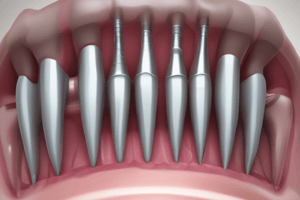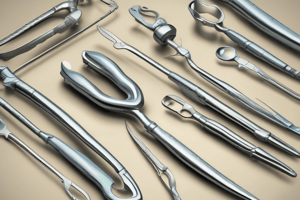Podcast
Questions and Answers
Which of the following is NOT a potential fetal complication associated with operative vaginal delivery?
Which of the following is NOT a potential fetal complication associated with operative vaginal delivery?
Which of these is NOT a crucial aspect of maternal assessment prior to an operative vaginal delivery?
Which of these is NOT a crucial aspect of maternal assessment prior to an operative vaginal delivery?
What is the purpose of pelvic assessment in the context of an operative vaginal delivery?
What is the purpose of pelvic assessment in the context of an operative vaginal delivery?
What is the main purpose of wound care after an operative vaginal delivery?
What is the main purpose of wound care after an operative vaginal delivery?
Signup and view all the answers
Why is obtaining informed consent from the mother a crucial step before an operative vaginal delivery?
Why is obtaining informed consent from the mother a crucial step before an operative vaginal delivery?
Signup and view all the answers
Which of the following is NOT a common indication for an operative vaginal delivery?
Which of the following is NOT a common indication for an operative vaginal delivery?
Signup and view all the answers
What is the primary distinction between forceps delivery and vacuum delivery?
What is the primary distinction between forceps delivery and vacuum delivery?
Signup and view all the answers
In what scenario would a combination of forceps and vacuum delivery be considered the most likely?
In what scenario would a combination of forceps and vacuum delivery be considered the most likely?
Signup and view all the answers
Which of these is NOT a crucial aspect of pre-procedure evaluation for an operative vaginal delivery?
Which of these is NOT a crucial aspect of pre-procedure evaluation for an operative vaginal delivery?
Signup and view all the answers
What is the primary reason for continuous monitoring of the mother and baby during an operative vaginal delivery?
What is the primary reason for continuous monitoring of the mother and baby during an operative vaginal delivery?
Signup and view all the answers
Which of the following is NOT a crucial consideration for ensuring a safe and successful operative vaginal delivery?
Which of the following is NOT a crucial consideration for ensuring a safe and successful operative vaginal delivery?
Signup and view all the answers
Why is documentation of the operative vaginal delivery procedure essential?
Why is documentation of the operative vaginal delivery procedure essential?
Signup and view all the answers
Which type of operative vaginal delivery utilizes instruments to grasp and guide the baby's head through the birth canal?
Which type of operative vaginal delivery utilizes instruments to grasp and guide the baby's head through the birth canal?
Signup and view all the answers
Flashcards
Maternal complications
Maternal complications
Issues during delivery such as lacerations and trauma.
Fetal complications
Fetal complications
Problems such as cephalhematoma and nerve palsy in the newborn.
Maternal assessment
Maternal assessment
Evaluating maternal history and vital signs before delivery.
Informed consent
Informed consent
Signup and view all the flashcards
Postpartum checks
Postpartum checks
Signup and view all the flashcards
Operative Vaginal Delivery
Operative Vaginal Delivery
Signup and view all the flashcards
Fetal Distress
Fetal Distress
Signup and view all the flashcards
Maternal Exhaustion
Maternal Exhaustion
Signup and view all the flashcards
Cephalopelvic Disproportion
Cephalopelvic Disproportion
Signup and view all the flashcards
Forceps Delivery
Forceps Delivery
Signup and view all the flashcards
Vacuum Delivery
Vacuum Delivery
Signup and view all the flashcards
Post-delivery Care
Post-delivery Care
Signup and view all the flashcards
Pre-procedure Evaluation
Pre-procedure Evaluation
Signup and view all the flashcards
Study Notes
Introduction to Operative Vaginal Delivery
- Operative vaginal delivery uses instruments to facilitate delivery when spontaneous delivery is difficult or impossible.
- It's a common procedure, crucial for maternal and fetal well-being.
- Indications vary by maternal and fetal conditions, and procedures differ based on instruments.
- Common instruments are forceps and vacuum extractors.
Indications for Operative Vaginal Delivery
- Fetal distress: Hypoxia or other problems requiring expedited delivery.
- Maternal exhaustion: Prolonged labor leading to fatigue and difficulty pushing.
- Cephalopelvic disproportion: Baby's head too large for the mother's pelvis.
- Prolonged second stage of labor: Labor extending beyond a safe time frame.
- Uterine rupture/scarring: Previous Cesarean or other uterine issues making vaginal delivery risky.
- Breech presentation: Baby positioned in a breech position.
Types of Operative Vaginal Deliveries
- Forceps delivery: Instruments grasp and guide baby's head towards the birth canal, often used in shoulder dystocia.
- Vacuum delivery: A vacuum cup applied to the baby's head for traction, used when forceps are not suitable.
- Careful vacuum extraction to prevent scalp injury is essential.
- Combination of Forceps and Vacuum: A combined approach is rarely used if single methods fail.
Key Considerations for Operative Vaginal Delivery
- Pre-procedure evaluation: Assessing maternal and fetal status is vital.
- Proper positioning & technique: Skilled personnel are critical for safe instrument use.
- Monitoring of mother and baby: Continuous vital sign monitoring during and after delivery.
- Post-delivery care: Close observation for complications in mother and newborn.
- Documenting the procedure: Comprehensive records of delivery details are crucial for patient care and legal purposes.
Potential Complications
- Maternal complications: Vaginal lacerations, perineal trauma, or episiotomy.
- Fetal complications: Cephalhematoma, facial nerve palsy, retinal hemorrhages.
- Procedural complications: Difficulties in instrument use or failed delivery attempt.
Maternal and Fetal Assessment Prior to Operative Vaginal Delivery
- Maternal assessment: Evaluating maternal history, current condition, and vital signs (heart rate, blood pressure).
- Fetal assessment: Checking fetal heart rate pattern, assessing fetal movements for distress.
- Pelvic assessment: Determining pelvic size and shape.
Post-Delivery Care and Monitoring
- Postpartum checks: Close monitoring of maternal and neonatal well-being for complications.
- Wound care: Attention to perineal or vaginal lacerations to promote healing.
- Pain management: Administering pain medication for post-procedure discomfort.
- Nutrition and hydration: Ensuring adequate nutrition and hydration for recovery.
Additional Considerations
- Informed consent: Detailed procedure explanation to the mother for written consent.
- Teamwork: Coordinated effort from medical professionals is essential.
- Ethical considerations: Decisions guided by high ethical standards prioritize patient safety and well-being.
Studying That Suits You
Use AI to generate personalized quizzes and flashcards to suit your learning preferences.
Description
This quiz covers the key concepts of operative vaginal delivery, including the indications and instruments used in the procedure. It highlights situations where operative intervention may be necessary to ensure the safety of both mother and baby. Brush up on your knowledge regarding fetal distress, maternal exhaustion, and cephalopelvic disproportion.




